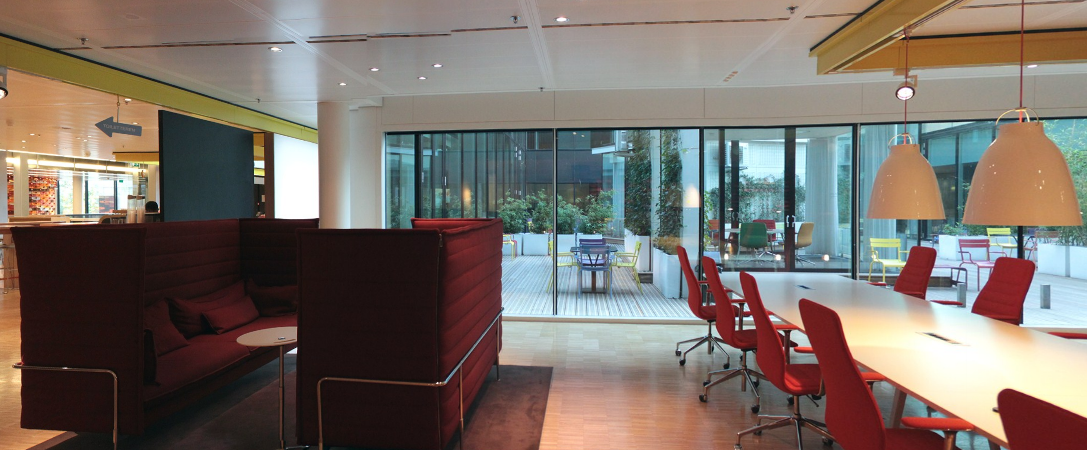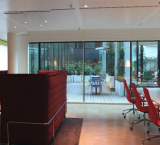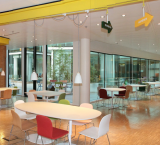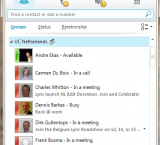Story:
How Microsoft Netherlands Reinvented the Way of Work (really)
This case study shows how Microsoft Netherlands (MS Netherlands) successfully implemented a radical and wide-ranging change to its management approach. Basically, they completely reinvented their way of working both physically and practically, leading to a substantial/dramatic increase in productivity and employee satisfaction.
In 2005, Microsoft’s Information Worker Thought Leadership Team released the White Paper “Digital Workstyles: The New World of Work” (in short NWOW), which provided a vision of how work will evolve in the future. MS Netherlands took them by the word when they moved into their new offices in 2008 and implemented the NWOW concepts for their entire organizational structure. Now in 2011, the numbers are in and the positive impact of the NWOW on productivity and employee satisfaction is a fact.
The implementation of the NWOW concept at MS Netherlands was initiated in 2005 under the project title “2bPr” (To be People ready) and entailed far-reaching changes in the physical, technological and psychological nature of work, involving changes in office design, rethinking the way of working, adopting new behaviors and getting rid of old practices.
Microsoft may not be the first company that comes to mind when thinking about openness and willingness to share insights. Nevertheless, Microsoft’s approach to adapting their organization to their vision of how work will evolve in the future is quite impressive.
During the Global Speakers Summit (GSS) in Holland in April 2011, Michael Hirt met Hans van der Meer, Marketing Manager at Microsoft Netherlands and co-responsible for the implementation of the organizational change at Microsoft Netherlands. Michael was impressed by Microsoft’s approach and their willingness to share their ideas and together they decided to publish a brief case study on MS Netherlands’ organizational transformation process here on the MIX.
MS Netherlands is a medium sized subsidiary of the Microsoft Corporation with approximately 900 employees. In comparison to the corporate headquarters of Microsoft, which is more focused on development, MS Netherlands has a more diverse workforce. The imminent relocation to a new building in 2008 was the crucial factor that made MS Netherlands the perfect subject for trying to translate the NWOW vision into real life organizational change.
Thus, MS Netherlands became the pilot project for aligning the organizational structure to the NWOW principles. The implementation was launched in 2006 under the project title 2bPr (To be People ready). To adapt to the envisioned new way of working, changes in the physical, virtual/technological and social/mental work environment became necessary.
Aspired goals of the transition process towards the NWOW were improving collaboration, knowledge sharing and creation in a dispersed virtual organization which ought to increase productivity, employee satisfaction, flexibility and boost innovation.
There were three main reasons why MS Holland decided to introduce radical organizational change:
- The changing business model for software developers such as Microsoft, due to changing customer behavior (people tend to pay for the use of software instead of buying it).
- The “practice what you preach” concept of Microsoft (creating a positive example of how their software and working concepts can improve company performance).
- A future decreasing labor force due to the ageing population demands to attract and keep the best employees by empowering employees with more freedom and accountability instead of more rules and regulations. In addition, sustainable growth in the face of a decreasing work force can only be achieved with increased productivity.
All started in 2005, with the decision to relocate the regional headquarters to a new building within the near future. For this reason MS Netherlands got into contact with MS Corporate and thus learned more about the vision of the “New World Of Work”. Subsequently it was decided that the upcoming relocation process was a perfect opportunity to realign the whole organization according to the NWOW vision.
When the entire 900 people team of MS Netherlands moved into their new premises in April 2008, and brought NWOW into reality, it was after nearly 3 years of intense preparation.
An “all hands” meeting kicked-off the process in 2005
The whole process was initiated by a general “all hands” meeting in 2005 at an external location, where the General Manager (GM) explained his dream of a new MS Netherlands. After his opening speech the participants were split up into smaller groups each working on one of the topics which should ultimately form the ten principles of the NWOW. All this was set up as an open dialogue, where every employee had equal rights to speak up and share his/her personal view on how the changes would affect him or her.
The general meeting was not without challenges. Hans van der Meer: “The most important lesson we learned was that it is pretty difficult to “listen” instead of reacting.”
Creation of a steering committee
Following the “all hands” meeting in 2005, a steering committee for the 2bPr project was formed, consisting of the country leadership teams and project managers.
This steering group defined the following targets for the implementation of 2bPr/NWOW at Microsoft Netherlands:
(1) really internalizing our mission (Realizing Potential) and vision (New World of Work)
(2) increasing collaboration within our company and with our customers, partners and co-creators
(3) be the most admired employer in the Netherlands
(4) be a showcase for productivity
(5) be a showcase for work-life balance
(6) be a showcase of The New World of Work, and
(7) ensure sustainable future growth (>10% YOY) with limited cost-increase (<5% YOY)
The steering committee was responsible for overall coordination of the three project groups working on the three crucial areas of adaptation:
(1) “Physical – Our Place” – focused on the new building
(2) “Virtual – Anywhere” – focused on the new digital work style and the technology to support it
(3) “Mental – Our Journey” – focused on the cultural and mental change, needed to support the changes
Work in the three project groups in 2006-07
Throughout 2006 and 2007, the three project groups arranged several meetings, brainstorming and dialogue sessions, in order to gather and develop knowledge and thoughts from the employees to further clarify the NWOW vision and 2bPr.
Realizing potential benefits from initiating change in the 3 areas of “physical”, “virtual” and “mental” was only possible by carefully balancing the relationships among them. Team participants needed to be aware of interdependencies and establish lines of communication early in the project.
It is also noteworthy, that although the time required at the start of the NWOW project was fairly limited, participation would become a half-time job once the final deadline drew near. Therefore it was crucial to provide the team members with enough time dedicated to the NWOW initiative to ensure a high quality output.
Development of guiding principles
After an extensive discussion process among the different stakeholders and based on the feedback collected during the annual employee survey, the following 10 NWOW principles were formulated to give a general guideline for implementing the new model:
- We work time and place independent
- Trust instead of control
- Output instead of presence
- Leadership instead of management
- Collaborate and work with clear goals and objectives
- Guidance instead of rules
- Dialogue versus sending in one way direction
- Use the right tools for the right job
- Share everything you do
- Take responsibility
This list makes the NWOW transition appear simple and to a certain extent sequential. In truth, however, the journey is much more iterative, which allows people to socialize the concepts, make them their own, and learn through trial and error what works.
Critical working practices
In the course of the project, the three teams implemented three working practices that made an important contribution towards achieving the NWOW vision. These practices focused on people and cultural issues:
- Analyze Employees’ Workstyles and Patterns to Identify Areas for Improvement - Based on a workforce analysis, it was possible to identify both, individuals who are already prepared to engage in their jobs effectively and, more importantly, those who need coaching to determine more efficient ways to work and more effective alignment with company goals.
- Pinpoint Early Adopters and Start a Pilot - Because they are willing to change and innovate, early adopters are likely good candidates for being departmental pilot leads or leaders for broader parts of the initiative. Their enthusiasm for the project acted as a peer catalyst for change.
- Develop a “Guided Discovery” Rollout - The lessons learned by MS Netherlands show that the cultural change toward a New Way of Working does not work using a top-down approach, although management leadership is still vital. Empowering people to discover how they fit into the new work experience helped them see that the concept is about satisfying needs at multiple levels, including their needs as individuals.
Communication as a key challenge
Everyone within the steering committee and the three project teams was well informed and working hard to make things happen. The rest of the organization, however, remained, at times, almost clueless about what was going on within the “closed circle” of the passionate but somewhat distant steering committee and the project teams.
It was critical to become aware of this disjunction and develop a pro-active approach to informing and keeping the entire organization engaged.
To keep the NWOW initiative top of mind and maintain momentum over the long term, regular communications were etablished through a mixture of already existing digital and physical communication instruments such as weekly newsletters, intranet project status sites, wikis, blogs, e-mail, and company meetings. Lateron, posters and “how-to” guides that people could take home were helpful too.
Also, detailed information on 2bPr was communicated to all employees in the course of the “Space for Growth Day” in September 2007 to accelerate the mental change process.
Move into the new building in 2008
The layout of the building is designed to maximize communication and collaboration. Transparency and open access to information is highly valued. Everyone has access to each other’s personal profile and calendar – including personal appointments during the day.
People are encouraged, whenever it is appropriate, to work more from home and are allowed to work whatever times they wish to work. The only requirement is “getting the job done”. If you wish to work until late at night on a project and take the morning to see your son’s school play, you can do that – and you don’t have to ask your manager for the time off.
Everyone is completely trusted to commit to their KPI’s and reviews are done regularly. Every employee has a weekly 1:1 with their manager that can be a physical or virtual meeting depending on the subjects. Two crucial moments in the official feedback process are the career development discussion in January and the performance review in July, during which you will not only assess what you achieved but also how you achieved it.
Implementing the NWOW principles had a big impact on managers. Due to the fact that the whole concept is based on trust and self-management, their role is changing to being a leader and mentor instead of a common business manager. In order to ease the transition MS Netherlands introduced MBTI (Myers-Briggs Type Indicator ®) and Haptonomy – the science of affectivity.
The “Virtual – Anywhere” and “Mental – Our Journey” teams cooperated to identify the technological needs and mindset changes necessary to work in the NWOW. Based on their findings, changes to the existing software were made and trainings to support the workforce in taking full advantage of the technological possibilities were developed.

MS Netherlands used a practical approach, so end users could develop both the mental and technical readiness required for the NWOW. “Personas” – how the technology could be used by typical workers – and “Scenarios” – how to improve everyday situations – are key.
Scenarios are all about rationalizing and standardizing common, everyday activities such as meetings, communication, e-mail, and project tasks with the goal of making each activity more effective. A Scenario describes how a future activity should be conducted to become more effective, mainly by eliminating inefficiencies in the process. A useful principle for describing the Scenarios that support the NWOW is to address the people, place, and technology characteristics of tasks.
It is impossible to achieve the vision of a NWOW initiative by only implementing new technologies. Success depends equally on capturing the way people work with and through technology, determining how place affects the efficiency of the technology, and addressing the level of distraction workers face.
At MS Netherlands, regular team meetings are used to demonstrate how people can work more effectively and how their team meetings can be enhanced by making better use of new Microsoft technologies such as Office Communicator, Windows Live Meeting, Microsoft RoundTable, Outlook, and SharePoint.
To make the “smarter” Scenarios more popular, employees were offered short training sessions (two-hour maximum) called “pimp my workstyle” and “I love e-mail and tasks.”
This approach has been successful: The top five implemented Scenarios are smarter meetings, smarter running projects, smarter communication, smarter knowledge and information sharing, and smarter e-mail and tasks.
To guide individual employees through the change management process more efficiently, several people were selected to become a ‘Floorwalker’ or ‘Buddy’ to “teach by doing” beyond the classroom. For instance, every new employee starts off with an intense one week program to get the in- and outs of MS Netherlands. First of all he has to set up at least 5 interviews with more experienced employees. Following the interviews a new employee can pick a buddy. The buddy is a person with at least 2 years of experience at Microsoft and is committed to help the new employee to get used to the NWOW at MS Netherlands.
The next step in the NWOW is developing personal leadership. Employees are encouraged to step up and “be the difference”. Employees are encouraged to share personal and career ambitions with their team members, so they can help each other in fulfilling and achieving those ambitions. Teams are formed based on a couple of principles: experience, learning curve, MBTI-profile, development and competencies. The virtual team manager is responsible for setting up the best team possible to get the job done, but has to make sure that there is enough room for personal development of the individual team members. Furthermore, it can be a team decision to appoint a member of the team to be a virtual manager for the next big project.
This form of collaboration requires special skills from a manager’s perspective. Teams are set up around initiatives and their members are in many cases also part of other virtual teams, just like a team manager can also be part of another team, playing a different role. Team managers are responsible for setting the goals and objectives based on the overall subsidiary scorecard (the “what”) and supporting team members in “how” and “when”.
To sum it up from a managerial perspective, the whole transformational process is designed to empower individual knowledge workers, by giving them the freedom to direct their work tasks and define their place and time to work themselves. To ensure the successful empowerment of employees, they have to have full access to all relevant information and tools that are now built around their work activities.
The adaptation to the NWOW vision at MS Netherlands is an ongoing process. We would suggest anyone who is interested in further details, to read up on Microsoft’s NWOW vision and the realignment process at MS Netherlands, starting with the document attached to this case study. Also it is possible to visit Microsoft Holland’s new office. Please fill in the form on: http://www.microsoft.com/netherlands/het_nieuwe_werken/contact_new.aspx
The intermediate outcomes for MS Netherlands are improved collaboration, knowledge sharing and creation in a dispersed virtual organization with final outcomes of increased productivity, satisfaction, flexibility and innovation.
Measurable improvements:
- Increased productivity by 25%
- Won “Great Place to Work” award in 2009, 2010 and 2011
- Employee satisfaction rose from 5/10 in 2008, to 8/10 in 2011
- Sick leave days are down to 1,5% from 2.5%
- Increased market reputation
- Increased Employees’ mobility
- Reduced real estate costs by 30%
Overall, the Netherlands’ software industry is growing at 4-5% per year, Microsoft Netherlands is growing at 11%.
These impressive results should encourage other organizations to change their way of work. Even without contemplating a new building or reinventing interior design, a NWOW transition remains a relevant journey. It will show both your employees and your customers how people, place, and technology issues merge to create more transparent, more effective, more attractive, and more productive work experiences.
Authors: Michael Hirt & Hans van der Meer
Michael Hirt is Managing Director of HIRT&FRIENDS Strategy Consultants, based in Austria. His colleagues Alexander Fuhri, Martin Maier and Eva Furlan contributed to the development of this case study.
Hans van der Meer is Marketing Manager at MS Netherlands and co-responsible for the implementation of the organizational change at MS Netherlands.
Maria Carlton, Chief Editor at the Global Speakers Federation (GSF), has written a note about the “Tour of Microsoft Holland” of the Global Speakers Network (GSN)”. Parts of this note have found their way into this case study – for the full note go to: http://www.globalspeakers.net/share/now/gsn_tour_of_microsoft_holland_hq/
The authors want to thank Michele Zanini from the MIX for his comments that helped to improve the case study.
1. White Paper “Digital Workstiles: The New World of Work” by Bill Gates et.al., 2005 – can be downloaded at:
http://www.microsoft.com/presspass/events/ceosummit/docs/NewWorldofWorkWP.doc
2. “Worlds of Work - Results from the New Worlds of Work Research Report 2007” (Final Report, May 1 2008) by Peter van Baalen et.al., RSM Erasmus University – document available on request – send email to: hansv@microsoft.com
3. White Paper “A New Way of Working - The 7 factors for success, based on Microsoft Netherlands experience“ by Mark Meerbeek et.al., 2009, Microsoft Corporation – document available on request – send email to: hansv@microsoft.com
4. Further images of the new Microsoft NL building near Schiphol - can be viewed at:
http://www.photosynth.net/userprofilepage.aspx?user=hansvandermeer
Michael,
We have done this 10years ago at Cisco and at E&Y. I have the ROI studies too if you care.
Maybe you can check with them (I left 6yrs ago) to see what the situation is now...
Gian
- Log in to post comments
- Log in to post comments
This is a really great case. Congratulations!!! I would love to learn more about how you want about increasing productivity. As well as what you feel made is successful. Would you be willing to set up a call? Jordan 917-488-9387
- Log in to post comments
- Log in to post comments









You need to register in order to submit a comment.